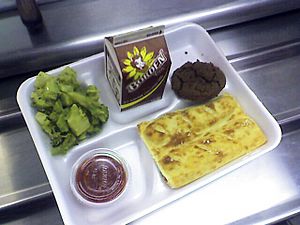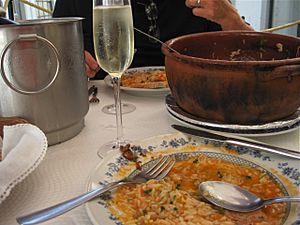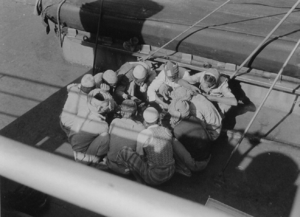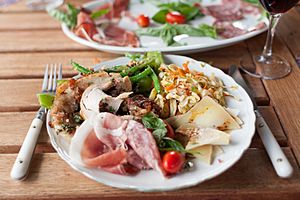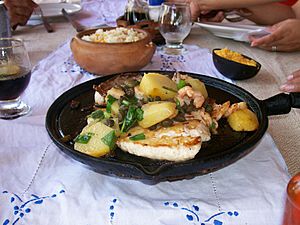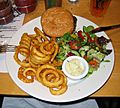Lunch facts for kids
Lunch is a meal usually eaten around noon or in the early afternoon. For most people, it's the second meal of the day, coming after breakfast and before dinner.
Lunch can be a cold meal, like bread and fruit, or a hot, full meal, similar to dinner. People who go to work or school often eat lunch with their friends or colleagues. Some bring their lunch from home in a lunchbox, while others buy it at a restaurant. In some countries, lunch is the most important meal of the day.
Contents
What's in a Name?
The word lunch is a shorter version of luncheon. This word comes from an old Anglo-Saxon word, nuncheon, which meant 'noon drink'. People started using the word lunch commonly around 1823.
Lunch Around the World
Asia
In Bengal, which is now split between Bangladesh and West Bengal, a traditional lunch can have seven different dishes! It often starts with a vegetable mix, then rice with dal (lentils) and vegetable curry. After that, there's rice with fish curry, and then rice with meat curry like chicken or lamb. For dessert, there are sweet treats like rasgulla and sweet yogurt. Finally, people might have paan to freshen their mouth.
In China, lunch today is simpler than it used to be. People often eat rice, noodles, or other hot foods. They might eat at a restaurant or bring food from home in a container. Western foods are also popular.
Europe
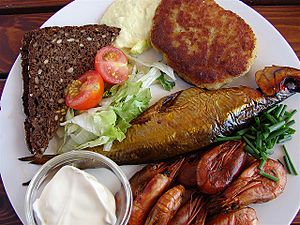
In Denmark, lunch, called frokost, is usually a light meal. It often includes rye bread with different toppings like liver pâté, herring, or cheese. Smørrebrød, which are open-faced sandwiches, are a special Danish lunch often served at business meetings.
In Finland and Sweden, lunch is a full, hot meal. It's usually one course, sometimes with small salads and desserts. Dishes can be anything from meat or fish to hearty soups.
In France, the midday meal is eaten between noon and 2:00 pm.
In Germany, lunch is traditionally the main meal of the day. It's a big, hot meal, sometimes with soup and dessert. It usually has protein like meat, starchy foods like potatoes, and vegetables or salad. Casseroles and stews are also common. Lunch is called Mittagessen, which means "midday's food."
In the Netherlands, Belgium, and Norway, people often eat sandwiches for lunch. They usually bring these from home to work or school and eat them in a canteen. The sandwiches can have sweet fillings like chocolate sprinkles or apple syrup, or savory ones like meat slices or cheese. The meal often includes coffee, milk, or juice, and sometimes yogurt, fruit, or soup. It's eaten around noon during a lunch break.
In Portugal, lunch (almoço) is a full, hot meal, much like dinner. It usually includes soup, a meat or fish dish, and dessert. It's served between noon and 2:00 pm. This is the main meal of the day in most of Portugal. The Portuguese word lanches comes from "lunch," but it means a lighter snack eaten in the afternoon, around 5:00 pm.
In Spain, the midday meal, also called "lunch," happens between 1:00 pm and 3:00 pm and is the main meal of the day. It usually has three courses: a first course like an appetizer, a main course (often meat or fish), and a dessert. People often have coffee or a small drink with dessert. Many workplaces and schools have restaurants where students and workers have a long break, at least an hour, for this meal. Many small shops close for two to four hours in the afternoon so people can go home for lunch.
Central Europe
In Hungary, lunch is traditionally the main meal of the day, often starting with a soup called leves.
In Poland, the main meal, called obiad, is usually eaten between 1:00 pm and 5:00 pm. It includes a soup and a main dish. Many Poles think of obiad as their "lunch" because it's the second of the three main meals. Some people also eat a "second breakfast" (drugie śniadanie) around 10:00 am, which is a light snack like sandwiches or a thin soup.
Eastern Europe
In Russia, the midday meal is eaten in the afternoon. Lunch is usually the biggest meal of the day. It often has a first course, usually a soup, and a second course with meat and a side dish. Tea is commonly served.
Southeastern Europe
In Bosnia and Herzegovina, lunch is the main meal of the day. It's a big, hot meal, sometimes with soup and dessert. It usually has protein (like meat), starchy foods (like potatoes), and a vegetable or salad. It's typically eaten around 2:00 pm.
In Romania, lunch (prânz) is the main hot meal of the day. It's usually eaten at 12:00 pm, but no later than 3:00 pm. Lunch normally has two dishes: a light soup first, and then a main course with meat and a side dish like potato, rice, or pasta. On Sundays, lunch is bigger and often includes an appetizer or salad.
Middle East
In the Middle East and most Arab countries, lunch is eaten between 1:00 pm and 4:00 pm and is the main meal. It usually includes meat, rice, vegetables, and sauces, and sometimes dessert. Water is commonly served, often with ice, along with other drinks like soft drinks or yogurt drinks.
North America
In the United States and Canada, lunch is usually a medium-sized meal eaten around noon. During the work week, people often eat a quick lunch like a sandwich, soup, or leftovers from dinner.
Children often bring packed lunches to school. These might have a sandwich (like bologna and cheese, or peanut butter and jelly), some fruit, chips, a dessert, and a drink like juice or milk. Adults might go out for a quick lunch, choosing a hot or cold sandwich like a hamburger or "sub". Salads, soups, tacos, burritos, sushi, and pizza are also common.
Lunch can be eaten at different types of restaurants, from casual to fast food. Canadians and Americans usually don't go home for lunch, and lunch breaks rarely last more than an hour, except for business lunches. Schools often have a cafeteria where children can buy lunch or eat their packed lunch.
In Mexico, lunch (Comida) is usually the main meal of the day, eaten between 2:00 pm and 4:00 pm. It typically has three or four courses: an appetizer (rice, noodles, soup, or salad), a main dish called a guisado with sides like refried beans or vegetables, and tortillas or bread. The third course is a dessert, coffee, and a small after-dinner drink. People often drink aguas frescas (fruit-flavored water) with their meal.
Oceania
In Australia, a light meal eaten between 10:30 am and noon is called brunch. An actual lunch is eaten between 12 pm and 2 pm. While brunch often includes fruit or cereal, it can also have burgers, sandwiches, or other hot foods. A meal in the late afternoon might be called "afternoon tea", which is usually smaller than lunch, sometimes just coffee or other drinks.
South America
In Argentina, lunch is usually the main meal of the day, eaten between noon and 2:00 pm. People eat a variety of foods like chicken, beef, pasta, and salads, with a drink and dessert. However, at work, people often have a quick meal like a sandwich or fast food.
In Brazil, lunch is the main meal of the day, eaten between 11:30 am and 2:00 pm. Brazilians typically eat rice with beans, salad, French fries, and some kind of meat or pasta. The types of food can change depending on the region.
Lunch Breaks and Working Lunches
Since lunch usually happens in the middle of the working day, people either take a break to eat it or eat it as part of their work. Whether someone takes a lunch break or works through lunch can depend on their culture, job, or even their boss. Sometimes, any meal break at work is called "lunch," even if it's in the middle of the night, especially for jobs with rotating shifts.
Gallery
-
Lunch foods at a Japanese restaurant in Hong Kong
-
Japanese cuisine: An udon lunch set
-
Vietnamese phở, commonly served as lunch
-
A Swedish outdoor picnic
-
Farmworkers taking a lunch break at Nieuw-Scheemda, Oldambt, Groningen, Netherlands, c. 1955
-
US President Barack Obama and Canadian Prime Minister Stephen Harper with aides during a working luncheon in the Canadian Parliament in Ottawa, Ontario, in 2009
Images for kids
-
In Britain, a pub ploughman's lunch includes bread and cheese. Shown here with a meat pie.
-
Luncheon of the Boating Party by French impressionist Pierre-Auguste Renoir, 1881.
-
Mrs Beeton's Book of Household Management, a guide to all aspects of running a household in Victorian Britain
-
Many restaurants serve lunch from a buffet rather than fixed portions.
-
An example of North Indian lunch
-
American lunch of a hamburger and French fries
-
A platter of lunch meats
-
Swordfish lunch
-
Fish and chips served for lunch at a restaurant in Finland
See also
 In Spanish: Almuerzo para niños
In Spanish: Almuerzo para niños


